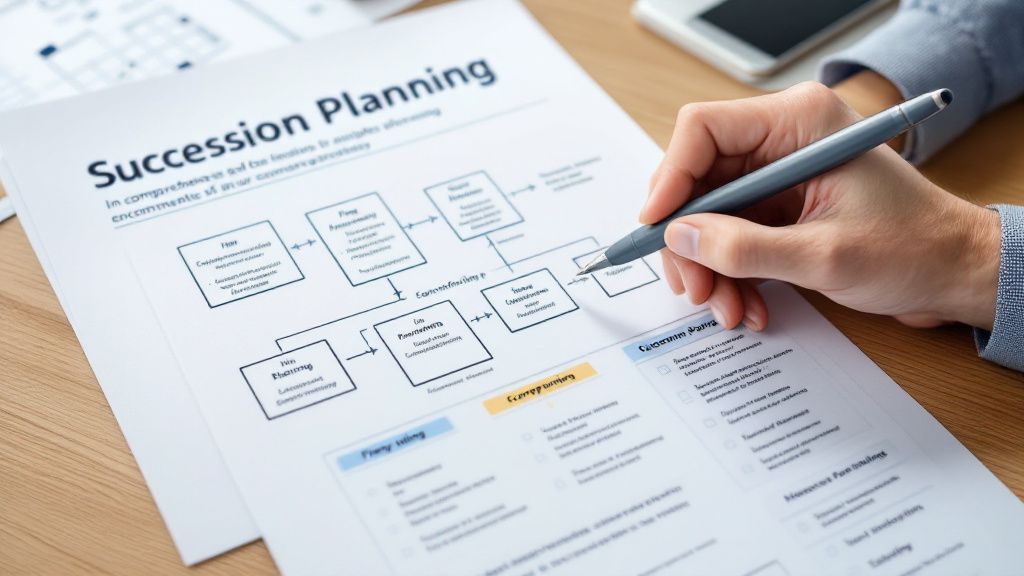Book Free Consult Call
Crafting a roadmap for successful business transitions begins with a clear understanding of what lies ahead. As you embark on the journey of planning, it's essential to focus on the continued success of your enterprise. Business continuity planning is pivotal in ensuring the seamless operation of your company amidst change. Succession planning becomes a vital tool, especially for family-owned businesses, to safeguard a smooth leadership transition. Whether you're exploring business exit strategies or prepping for family business succession, each step requires careful consideration. By navigating these complexities thoughtfully, you're better positioned to drive sustained growth and stability during important transitions.
Understanding business transitions is essential in preparing for inevitable changes within your company. At its core, a successful transition involves a strategic shift in leadership or ownership while maintaining operational stability. During this period, you must anticipate challenges that could disrupt your organization’s journey. This understanding lays the groundwork for developing effective strategies aimed at ensuring smooth transitions without compromising business integrity.Effective succession planning plays a crucial role in this process, especially for family-run businesses, where relationships add another layer of complexity. Balancing personal dynamics with professional responsibilities calls for careful consideration. To prevent potential issues, maintaining open communication and establishing clear procedures well in advance fosters trust and clarity among all stakeholders.Business transition also encompasses exploring various business exit strategies when transferring leadership. Options such as selling the company, mergers, or leadership within the family should be assessed judiciously. Each path requires meticulous planning to align with your long-term objectives, ensuring both you and your business achieve favorable outcomes during the evolving phase.To make the most of these transitions, consider holding regular workshops or mentoring sessions. They can clarify roles and set expectations among team members, thereby reinforcing your business continuity planning efforts. By focusing on strategic planning and open dialogue, you set a strong foundation for juggling change efficiently and effectively.
Types of business transitions each bring distinct challenges and opportunities. One common form of transition occurs when leadership changes due to retirement, often seen in succession planning. This could involve grooming an internal leader or even a family member in a family business succession scenario. Such transitions demand detailed planning to ensure the company's vision and core values persist through generations.Another prevalent form is during mergers and acquisitions. These transitions blend two organizations into one cohesive entity, impacting the corporate culture, customer base, and employee roles. Successfully navigating this type of transition requires adopting comprehensive business continuity planning. This approach helps maintain stability and communicate new goals effectively to all parties involved, ensuring a seamless integration process.Sometimes transitions focus on business exit strategies, where owners seek to divest. This might include selling the business to a larger corporation or transferring ownership to a new group entirely. Here, the emphasis is on maximizing valuation and aligning the transfer with strategic goals. Evaluating your exit strategy should be done with careful consideration of your financial and personal objectives.Internal restructuring, another transition type, looks at redesigning organizational processes to improve efficiency. While beneficial, it comes with the risk of disrupting existing workflows. You must strike a balance between implementing new systems and maintaining daily operations. Focusing on employee involvement during this process is crucial to successfully implement changes without unsettling the work environment.One unpopular opinion about business transitions is that not every company needs a drastic change to remain competitive. Some argue that minor adjustments and improvements can effectively sustain growth. Evaluating the necessity of transitions against their potential impact allows for making informed decisions that best suit your business’s unique context. Prioritizing deliberate, well-planned changes avoids unnecessary disruptions and helps sustain long-term growth.

The role of leadership is crucial during business transitions, as leaders set the tone and direction for change. Effective leaders focus on clear communication and strategic planning to guide the organization through uncertainty. Their ability to maintain the team's morale and align objectives plays a pivotal role in ensuring smooth transitions, whether dealing with succession planning or implementing business exit strategies.In family business succession, leadership involves navigating complex family dynamics while nurturing talent. The leader's responsibility extends beyond business acumen, requiring emotional intelligence and diplomacy to achieve a successful handover. A well-prepared leader ensures continuity and addresses potential conflicts by fostering an inclusive, forward-thinking environment.On one hand, some believe that leadership in transition is about maintaining control and executing detailed planning to counter transitional challenges effectively. Others argue that effective leadership is characterized by flexibility, openness to feedback, and adaptability, which empower teams to innovate during the transition period. Balancing these perspectives helps leaders manage transitions more holistically.Leadership also plays a critical role in business continuity planning. A proactive approach from leaders involves preparing contingency plans and anticipating potential disruptions to business operations. This ensures processes remain robust and adaptable as the company navigates through different phases of change, safeguarding both short-term and long-term interests.

Succession planning is a fundamental component of ensuring sustainable leadership transitions in any organization. To be effective, it involves identifying and developing potential leaders who can assume key roles when vacancies arise. This proactive approach prevents disruptions and ensures business continuity, aligning with your long-term strategic goals. A well-structured succession plan holds the key to a seamless leadership change.In the context of family businesses, succession planning requires additional care, blending personal and professional considerations. Here, it’s crucial to nurture potential successors within the family while maintaining transparency and fairness. Addressing these complexities early can help mitigate conflicts and create an environment of trust. This foresight ensures a stable future rooted in shared family values.To truly understand succession planning, you need to shift your mindset from seeing it as a one-time event to viewing it as an ongoing process. Incorporating succession into daily business practices fosters a culture of continuous leadership development. This mindset shift emphasizes the importance of adaptability and readiness, creating a solid foundation for your business's evolution and longevity.Effective succession planning includes business exit strategies that are well-aligned with your organizational goals. Whether that involves internal promotion or external recruitment, your focus should remain on positioning the business for continued success. This strategic perspective ensures that leadership transitions enhance, rather than disrupt, business momentum.

Creating a succession strategy involves a detailed plan that aligns with your business’s long-term goals. This strategy should start with identifying key positions and potential successors within your organization, ensuring they possess the necessary skills and traits to lead. By actively developing talent, you build a robust pipeline that guarantees leadership readiness when a transition becomes necessary, enhancing resilience and sustainable growth.The current state of succession planning highlights a trend towards integrating technology and data analytics. Companies now utilize data-driven insights to predict leadership potential and assess the skills required for future roles. Embracing these tools allows you to make informed decisions about talent development and succession readiness, positioning your organization at the forefront of modern business transitions.Incorporating business continuity planning within your succession strategy ensures your company can withstand leadership changes without losing momentum. Whether addressing family business succession or implementing business exit strategies, embedding these practices strengthens your organization’s structure. By doing so, your company remains agile and prepared for any unanticipated changes, ensuring stability and continuity in an ever-evolving business landscape.
Legal considerations are foundational to effective succession planning, encompassing a range of areas from contracts to estate planning. One critical aspect includes documenting clear organizational structures and roles to eliminate ambiguity during leadership transitions. By ensuring legal documents such as wills, trusts, and power of attorney are up-to-date, you facilitate a smoother process and protect both personal and business interests during succession.For family business succession, legal agreements can help preserve family harmony and business stability. These agreements spell out the roles and responsibilities of family members in the business, minimizing disputes and aligning family goals with business strategies. Consulting with legal professionals aids in drafting agreements that reflect the unique dynamics of family businesses, aimed at ensuring positive outcomes for all stakeholders involved.In the next few years, succession planning is likely to become more regulated, requiring businesses to comply with enhanced legal standards and disclosure practices. As companies face increasing scrutiny, engaging legal expertise early in the planning process can prepare your business for upcoming legislative changes. This proactive approach secures your succession plans, minimizes legal risks, and ensures your transition strategy aligns with emerging regulatory requirements, fortifying long-term business health.
Stay up to date on all things business, stratgey, leadership growth, and more by subscribing to the TruNorth Newsletter.